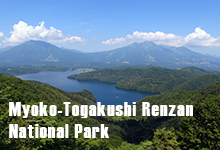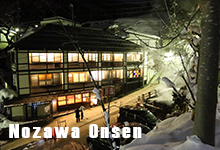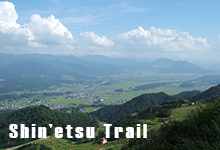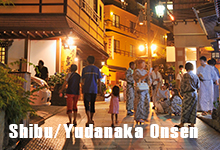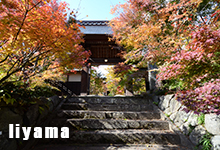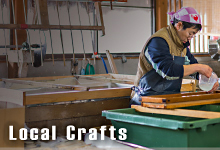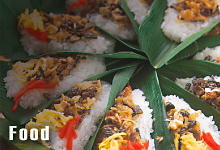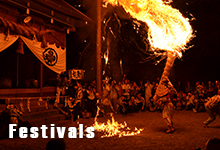
CULTURE
MATSURI(Festivals)
The Shinetsu Shizenkyo region boasts a rich culture, with many traditional festivals and historical performance arts passed down through generations. The scales of these festivals are wide-ranging: from individual shuuraku villages to larger amalgamations
of towns.
Participating in these festivities provide a unique insight into the region, the values and lives of the local population, as well as the distinct atmosphere of Japanese history and culture.
Nozawa Onsen Dosojin Festival in Nozawa Onsen Village
(National Significant Intangible Folklore Cultural Property)
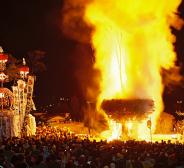
After the dawning of the New Year, regions across Japan carry out rituals and festivals to ward off a year s worth of evils and misfortunes. As such, the biggest scale and most crucial event in Nozawa Onsen Village, the Nozawa Onsen Dosojin Festival is
held on January 15th annually; and happens to be renowned world-wide as being one of the three largest-scale fire festivals in Japan.
The climax of the festival is a 1.5hr fire battle that the village population engages in; then the shrine is set ablaze, creating a pillar of fire, and continues to burn all night. It is said that grilling mochi rice cakes
on the remaining flames the following morning and eating it for breakfast will prevent you from catching a cold all year long.
Sekiyama Jinja Hi Matsuri in Myoko City
(Prefectural Significant Intangible Folklore Cultural Property)
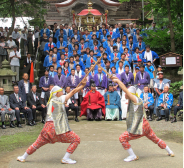
Held every July at the Sekiyama Jinja at Myoko Kogen, the festival includes performances such as "Kariyamabushi no Boutsukai" and "Hashiramatsu Gyouji" which have been deemed as Niigata Prefectural Significant Intangible Folklore Cultural Property. Youths from the village dress as Buddhist mountain monks-in-training and demonstrate their skills with swords and spears in a stylized performance battle in "Kariyamabushi no Boutsukai". "Hashiramatsu Gyouji" is a race to see who can light pillars of firewood, arranged south to north, the fastest. It is said that the winner's village will produce good rice crops that year. Ritual Sumo matches and a parade carrying a portable Mikoshi shrine are also amongst the highlights.
Daidai Kagura in Iiyama City
(Prefectural Significant Intangible Folklore Cultural Property)
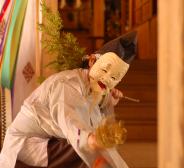
The Gosoku Daidai Kagura at the Takeminakata-tominomikoto-hikokamiwake jinja shrine is famed for the Izumo style Kagura dances ? Noh dances performed with bells and Oogi fans alongside prayer incantations. The dances have a long and rich history; developed in the late 16th Century, generation after generation have inherited and performed them. There are 10 routines still in practice, and can be viewed twice a year in May and September. They have even been featured in a film set in Iiyama!
Hinaichi (Clay Doll Market) in Nakano City
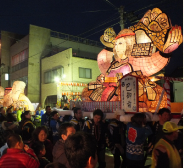
Nakano City's annual event is held across the 2 days of March 31st and April 1st, and celebrates the folk toys, Nakano Clay Dolls, or Tsuchibina.
Nakano City draws clay doll fans from all over Japan for its specialized production in not one, but two types of clay dolls - the rounded and cute Nakano dolls and the vibrant and intricate Tategahana dolls. The event
also increases the distinct spring feeling in Northern Shinshu by bringing together the "National Clay Doll Market" ? the only market where you can find traditional clay dolls from all over Japan; and a parade of large, clay-doll-shaped
lanterns.
See here (for details)


